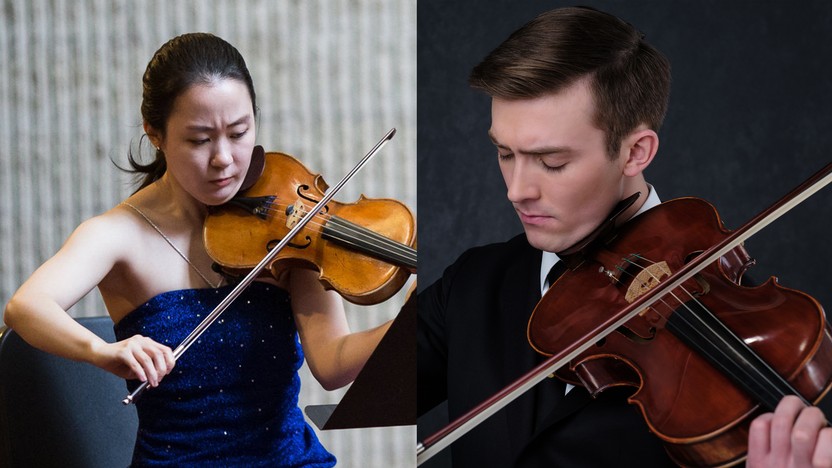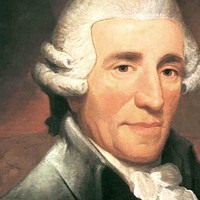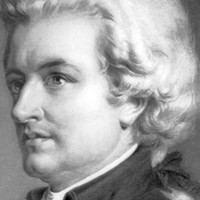Mozart’s Sinfonia Concertante for Violin and Viola



In 1782, Franz Joseph Haydn wrote a set of three symphonies (numbers 76-78) that he intended to have performed in England. These were the first of the “father of the symphony’s” orchestral works to be conceived of as a set for publication, and they were also the first since 1761 to be written for an audience abroad. Haydn’s trip to London fell through, however, and he sent the symphonies to his Parisian music publisher the next year.
These three symphonies codified Haydn’s developing popular intellectual style, which combined catchy melodies with clever manipulations of form, harmony, and counterpoint. Haydn himself described them as “beautiful, magnificent and by no means over-lengthy…very easy, and without too much concertante.”
Only eleven of Haydn’s 108 symphonies are written in minor keys, including Symphony No. 78. This was the first symphony to be written in a minor key after his Sturm und Drang (storm and stress) period. However, much of Symphony No. 78 is in major tonal centers, thereby obscuring the profundity often associated with minor works at this time.
The stoic and jagged opening theme of the first movement suggests that this work will continue in Haydn’s Sturm und Drang style, a proto-Romantic movement in German literature in which extreme emotions are freely expressed. Artistic works in this style were conceived as a reaction to the perceived constraints of Enlightenment rationalism. Yet the somber opening theme of Symphony No. 78 quickly gives way to music that is much brighter, indicating that this symphony is going to portray a number of contrasting affekts or characters.
The slow second movement unfolds as a gentle drama, which creates a sense of reflection or nostalgia. This is immediately followed by a lively and humorous Minuet and Trio, which contains sudden shifts between loud and soft dynamics. Major and minor keys are alternated between sections of the lively variation-rondo finale. As the movement progresses, Haydn uses sudden silences, changes in key, and imitative counterpoint to heighten the angst. A festive coda concludes the work in the cheerful key of C major.
Paula Maust ©2022

Doubling Back is a reimagining and expansion of my duo Circling Back for Oboe and Cello, commissioned by The Saint Paul Chamber Orchestra in 2021. In some ways, it’s similar to its predecessor: the pieces share the same melodies, harmonies, and structure. However, the larger ensemble of Doubling Back allows for a broader range of textures and variation, and the piece is therefore a deeper exploration of material I enjoyed writing the first time around. Revision and adaptation have long been parts of my compositional process, and this quintet is an emblem of what can happen when you double back on your own musical material.
Viet Cuong ©2022

Wolfgang Amadeus Mozart, the onetime child prodigy who had dazzled audiences all over Europe, found himself in an unexpected predicament in his early twenties: he was stuck in his hometown of Salzburg. He resigned from the court of the local Archbishop in 1777 and set out with his mother in search of new employment, but his visits to Mannheim and Paris failed to produce any real prospects. At least he came away from his time in Mannheim, home to one of the world’s finest orchestras, with a new arsenal of brilliant ensemble effects.
Mozart returned to Salzburg in 1779 and begrudgingly resumed working for the Archbishop. On the side, he cultivated his own private circle of musicians and patrons, for whom he wrote symphonies, concertos, serenades, and other entertaining diversions. We don’t know exactly the circumstances that led to Mozart composing the Sinfonia concertante for violin and viola in 1779, but we can presume that it was some social event in Salzburg. Mozart, a fine violinist and violist, would surely have played one of the solo parts.
The idea of a concerto for multiple soloists had been around for nearly a century (in the form of the concerto grosso), but the sinfonia concertante was a trendy new approach flourishing in places like London, Mannheim, and Paris — where Mozart actually wrote his first example for a quartet of soloists. In the Sinfonia concertante for violin and viola, Mozart addressed the natural imbalance in projection by calling for the viola to be tuned a half-step higher than normal, increasing the alto instrument’s power. (Modern instruments and metal strings have alleviated this need, so today’s soloists often forgo the transposition.)
One of the sounds Mozart picked up in Mannheim was a long crescendo that gathers strength over a constant bass note, a device so characteristic of the local composers that it was dubbed the “Mannheim roller.” A terrific example is the final climax of the tutti exposition that precedes the arrival of the soloists.
The central Adagio movement unwinds its haunting main theme in skeins of long, singing phrases that weave between the two solo instruments. As in the first movement, the two soloists share a fully composed cadenza, imparting a chamber-music intimacy to this orchestral score. The finale continues the impressive display of ensemble colors, including prominent passages for the horns and oboes, all in support of quick-witted banter between the soloists.
Aaron Grad ©2024
Get driving directions and find nearby parking.
Find dining options close to the venue.
View seating charts to find out where you'll be seating.
Get driving directions and find nearby parking.
Find dining options close to the venue.
View seating charts to find out where you'll be seating.
